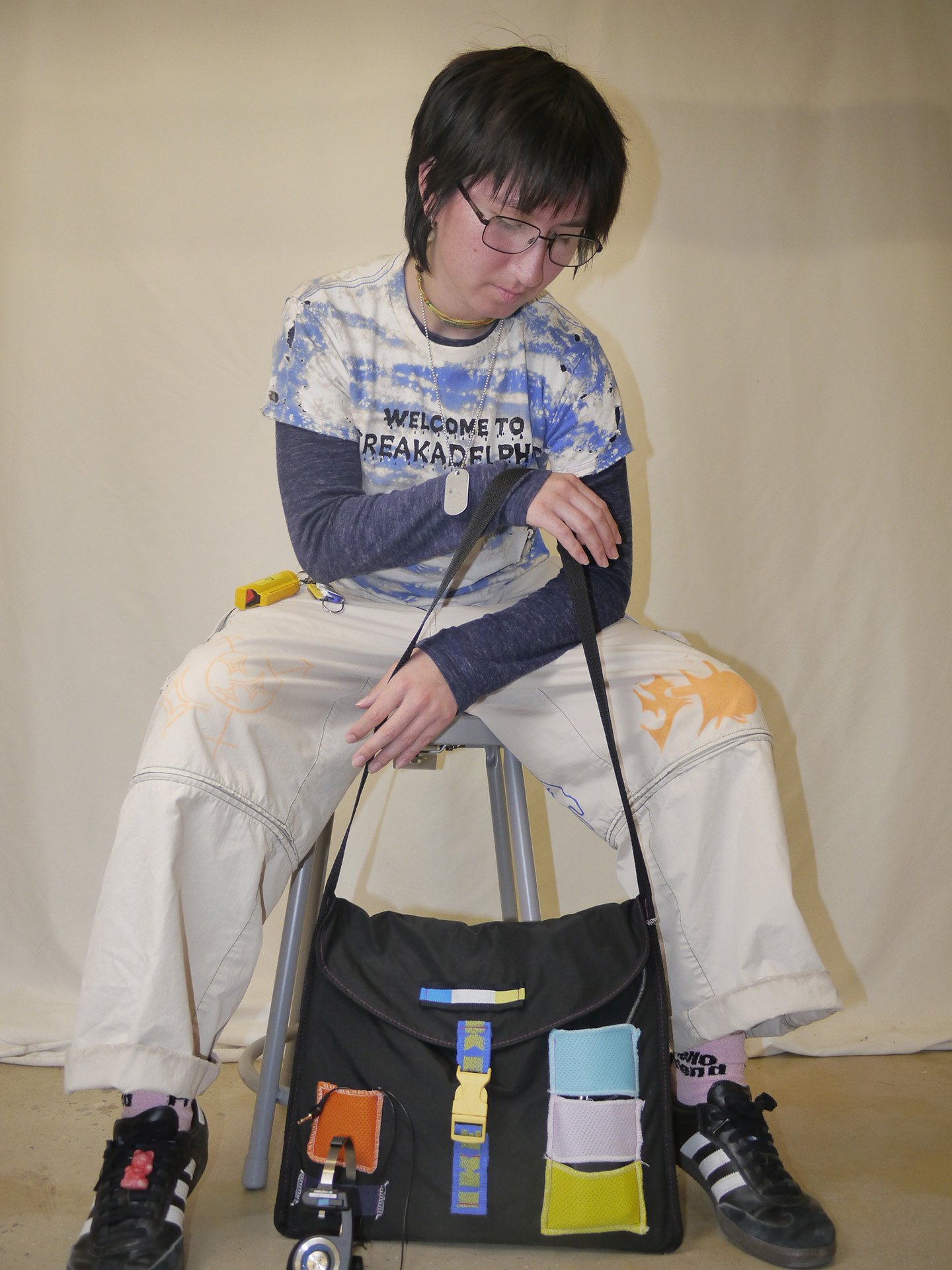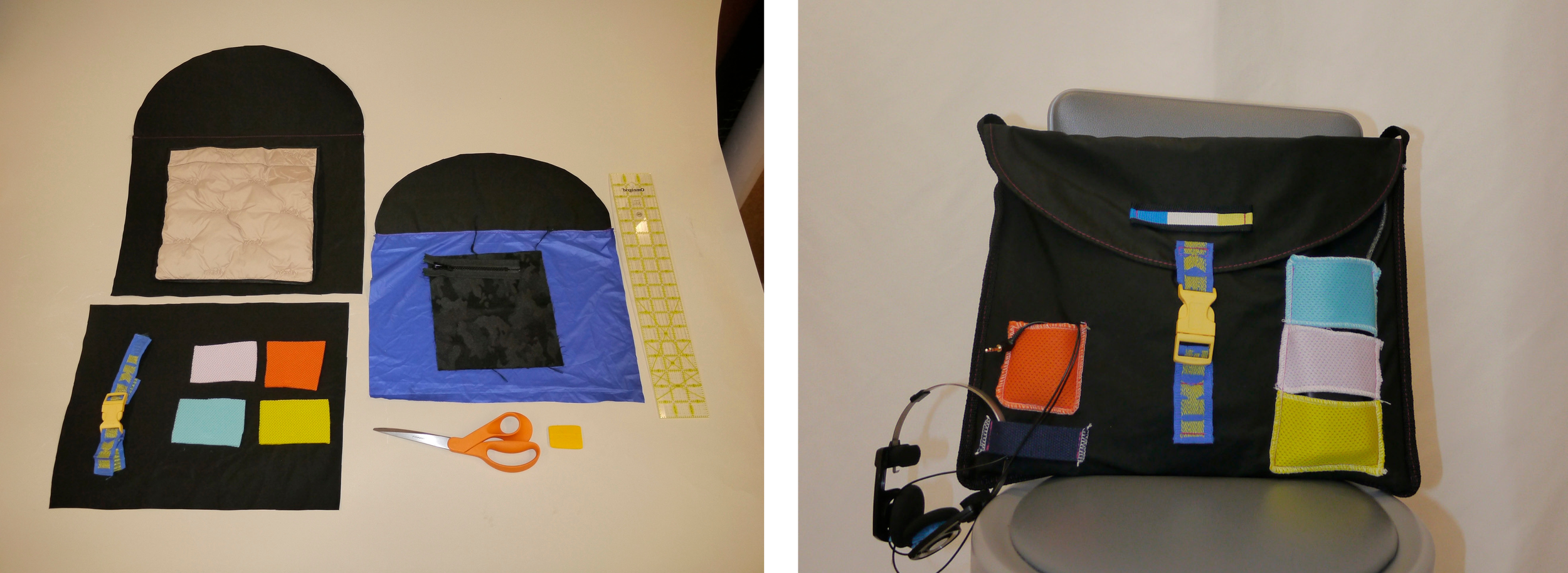The Transformation from Scraps to Style
Galaxie Cantú
Westphal Product Design ’27
Galaxie Cantú (they/he) is a Product Design major at Drexel University and a former intern at FabScrap from South-West Los Angeles. Their art centers on "using what you have to make it work for you." By repurposing materials from FabScrap, Galaxie’s designs tell a story of creativity and a sustainable approach. Galaxie’s internship at FabScrap was a turning point in understanding the potential of recycled fabrics. “FabScrap changed my perception of sustainability,” they say, having seen firsthand how old materials can be transformed into something entirely new and valuable. One of Galaxie’s most memorable creations was last year’s Westphal College of Media Art and Design’s Garbage Gala piece- entirely made of recycled FabScrap materials.
For Galaxie, design is both a form of self-expression and a way to navigate identity. "How can I exist in spaces with people who are mixed, transmasc, and who go through mental/physical health problems just like me?" They ask. This question runs through the fabric of their work as they explore color and texture and themes of identity and mental health. Color is an essential element—teal and yellow, pastel tones, and rich hues are their palette of solace. “I don't see things in black and white,” they explain. "Color is my foundation." Whether it’s tailored clothing, fun knitwear, or reworked accessories, their work reflects a mix of personal struggles, cultural identity, and a love for music, with artists like Blood Orange and Rosalia’s Motomami on repeat while they design.
The challenge of navigating a rapidly changing world, particularly the pressures of sustainability, also fuels their drive. Galaxie is outspoken about the environmental toll of the fashion industry and its role in overconsumption. “In terms of climate change, there’s a bitterness inside me that will never go away because of it,” they say. This frustration manifests itself in their designs, where every stitch is a protest of the wastefulness of fast fashion.
Now, Galaxie is focused on continuing their work, including an exciting future collaboration with @psycsensory, a start-up streetwear designer for individuals who experience overstimulation. I asked Galaxie to create an accessory that represents themself with sustainability in mind. Made entirely of FabScrap materials, this laptop case consists of recycled fabrics, clasps, zippers, and memory foam pockets.
Miranda Martel
Westphal Fashion Design ‘27
Miranda Martel’s love for fashion design is deeply rooted in her childhood, where her ideas were sparked by her mother’s work as a designer. Now a sophomore at Drexel University, Martel channels that early influence into designs that balance innovation with sustainability. “My mom is my biggest fashion inspiration,” she says. She taught me that fashion can be art and storytelling.” Her own work merges a love of avant-garde design with a commitment to minimizing fashion’s environmental impact.
Martel constantly mixes her craftsmanship with exploration. “One of my biggest achievements was my recent creation of a mini collection for my materials exploration midterm, where we had to design and drape 1.5 yards of fabric,” she explains. But her work doesn’t stop at the surface. As a young designer, Miranda is particularly invested in how fashion can reduce waste and minimize harm to the planet. She tackles this issue by choosing sustainable materials, such as a bin full of students’ unwanted fabric waste. Filled with denim scraps, ripped sweaters, and accessories such as ribbons, buttons, and lace scraps, these bins are filled with options for reworked garments. “Reworked fashion is so beneficial to the industry,” she explains, emphasizing its impact on reducing water consumption and CO2 emissions. Sustainability isn’t just an idea for Martel—it’s a core principle that guides her choices, from fabric selection to design execution.
Martel is inspired by the boundary-pushing designs of Schiaparelli and Cult Gaia — two brands she admires for their fearless approach to fashion. “Their designs are out-of-the-box, and that’s something I aspire to in my own work,” she says. Her goal is to merge chic with sustainability, proving that responsible fashion can still be beautiful and accessible. “I think as young designers, we can so easily access information online; it’s important to use that and be informed. That way, we can make better choices for the environment as we go about making things.” She believes that as young designers, it’s crucial to tap into the vast amount of information available online to make informed, ethical decisions about materials and production. “We have the power to change the industry,” she asserts, “and it starts with making better choices from the beginning.”
For Miranda’s Materials Exploration midterm, I followed her journey of creating a fashion collection- designing and draping 1.5 yards of fabric into three stunning cohesive pieces, with materials retrieved from both donated students’ fabric waste and Fleishman’s Fabric Philadelphia.
FabScrap Background
One of the most impactful non-profit organizations leading a charge against textile waste and supporting student designers is FabScrap. By partnering with more than 900 brands, they offer a comprehensive service, including regular or on-call fabric pickups and a well-organized process for sorting materials. FabScrap operates a warehouse and online services in Brooklyn, NY, ensuring access to materials for local creators. Donations of excess fabric allow designers and students to benefit from this sustainable initiative, with high-quality, upcycled textiles available at affordable rates. Individuals can recycle fabric scraps at a minimal fee of $2 per pound, ensuring that even small-scale creators can participate. Since its establishment, its innovative recycling programs have diverted over 1 million pounds of fabric from landfills. By providing over 100,000 pounds of reusable fabric annually, FabScrap reduces fashion’s impact on the planet while offering resources to the next generation of sustainable designers.







